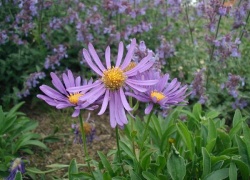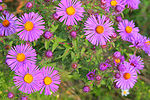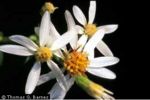Aster
| Aster |
|---|

|
| Scientific Classification |
|
| Species |
|
The genus Aster is considered a forb or herb made up of many similar flowers that are native to North America, and are often considered wildflowers and sometimes weeds. In Europe, however, they are cultivated as garden flowers.[1] It is a perennial flower that grows mostly in the spring and the summer. The Aster has a slow growth rate, but lives relatively longer than most other flowers. Asters can reach anywhere from 4 inches to six feet, depending on the species, at 20 years.[2]
Anatomy
The Aster has a single crown on top of an erect stock. The crown of the flower is not actually one flower, but many different flowers together. The central disc can contain up to 300 tiny individual flowers.[3] The flower is easily identifiable on all species of Aster, and has many separate petals. It has a coarse green foliage that is porous in all seasons. [4]
Asters are separate from other species of flowers because of their unique compound flower structure. They are also unique because the head of the flower looks like a star, which is what Aster means in Greek. They can be identified by their showy flowers and vast variety of colors.
Reproduction
The Aster blooms from summer to early fall, and can be propagated by seeds or by container. It has a low seed spread rate. Asters can spread relatively quickly, which is why many people consider them a wild flower. They still tend to stay in their native region, and are usually not found in areas in the western United States.[5]
Ecology
The Aster can grow in most textures of soils. It can survive in temperatures as low as 28 degrees Fahrenheit below zero. It grows in soil with a pH between 6 and 7.5. It is fed upon mostly by larvae, but it is not harmful to other species such as livestock.[6] Despite its reputation as a wild flower, gardeners often cultivate the Aster as well.
Commercial Uses
The Aster is used widely in commercial flower businesses because of its varying colors and shapes. The China Aster is one of the most commonly used flowers, but is actually an Asian plant part of a related genus and not part of the Aster Genus. Packets of Asters are usually sold for around 2 dollars, and can then be grown right in a garden.[7]
Asters are used in gardening to add color to the garden and because they are easy to grow. Species like the Aster novi-belgii are commonly used in the UK because they provide color to the Christmas season when most other perennials have started to die.[8]
New England aster
(A. novae-angliae)
Related References
- Asters The Free Dictionary
- Seed Prices Seedman.com
- Genus Information USDA Plants
- Gardening with Asters BBC










